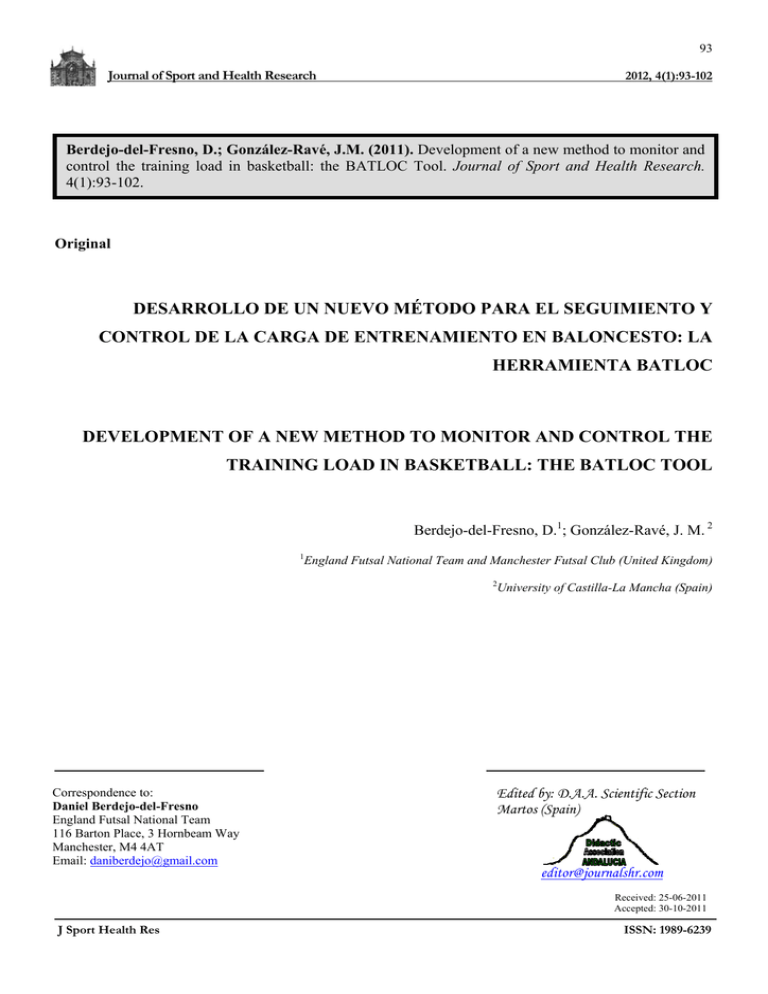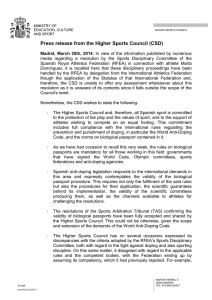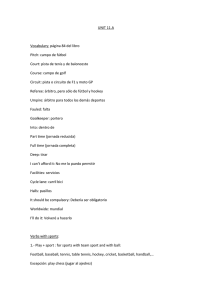BATLOC Tool - Journal of Sport and Health Research
Anuncio

93 Journal of Sport and Health Research 2012, 4(1):93-102 Berdejo-del-Fresno, D.; González-Ravé, J.M. (2011). Development of a new method to monitor and control the training load in basketball: the BATLOC Tool. Journal of Sport and Health Research. 4(1):93-102. Original DESARROLLO DE UN NUEVO MÉTODO PARA EL SEGUIMIENTO Y CONTROL DE LA CARGA DE ENTRENAMIENTO EN BALONCESTO: LA HERRAMIENTA BATLOC DEVELOPMENT OF A NEW METHOD TO MONITOR AND CONTROL THE TRAINING LOAD IN BASKETBALL: THE BATLOC TOOL Berdejo-del-Fresno, D.1; González-Ravé, J. M. 2 1 England Futsal National Team and Manchester Futsal Club (United Kingdom) 2 University of Castilla-La Mancha (Spain) Correspondence to: Daniel Berdejo-del-Fresno England Futsal National Team 116 Barton Place, 3 Hornbeam Way Manchester, M4 4AT Email: [email protected] Edited by: D.A.A. Scientific Section Martos (Spain) [email protected] Received: 25-06-2011 Accepted: 30-10-2011 J Sport Health Res ISSN: 1989-6239 94 Journal of Sport and Health Research 2012, 4(1):93-102 RESUMEN ABSTRACT Una carga de entrenamiento adecuada es esencial para lograr el mejor rendimiento y evitar lesiones. Sin embargo, controlar y supervisar la carga de entrenamiento en tiempo real en deportes de equipo es muy difícil, ya que no existe un método o herramienta fácil, barato y no invasivo. El sencillo software descrito en este artículo, creado en Microsoft Excel, puede ser utilizado para predecir la carga de entrenamiento y planificar una apropiada periodización de la carga de entrenamiento en el futuro durante la pretemporada y temporada en baloncesto. An adequate training load is essential to achieve the best performance and avoid any injuries. Nevertheless, to control and monitor the training load in real time in team sports is quite difficult, since there is no easy, cheap or non-invasive method or tool. The simple software described in this article, created in Microsoft Excel, can be used to predict the training load and plan a proper periodization of the future training load during the pre-season and the inseason training phase in basketball. Palabras clave: periodización, deporte de equipo, carga de entrenamiento. Keywords: periodization, team sports, training load. J Sport Health Res ISSN: 1989-6239 95 Journal of Sport and Health Research INTRODUCTION The main objective of a coach is to optimize athletic performance (Coutts and Aoki, 2009). The best performance improvements come from prescribing an optimal amount of physical training with proper recovery periods to allow for the greatest adaptation before competition (Gamble, 2006; Coutts and Aoki, 2009). However, for coaches of team sports, there are few simple methods of controlling training loads (TL). Kelly and Coutts (Kelly and Coutts, 2007) affirmed that a common problem for coaches of team sports is determining the appropriate TLs to be prescribed during the competition phase of the season. Factors such as the quality of the opposition, the number of training days between matches, and any travel associated with playing away games all influence the between-match periodization of TLs. Many different methods of recording TLs in sports have been reported. Some of these methods have included measurement of heart rates (Banister et al., 1986), distance covered during training (Costill et al., 1991), weights lifted, repetitions completed, and training time. The session-RPE method to monitor TL requires each athlete to provide a Rating of Perceived Exertion (RPE) for each exercise session along with a measure of training time (Foster et al., 1998; Foster et al., 2001). Another method is the Training Impulse (TRIMP) method, proposed by Bannister et al. (1975) and based on the training time and average heart rate. This approach is very simple; however, it does not distinguish between different levels of training. Therefore, it has been mainly used to determine general load in aerobic-endurance sessions, which is the reason why it was later modified by Banister (1980) and became based on the increase in heart rate, gradually measured. It is calculated as the duration (in minutes) multiplied by an intensity factor which is differently defined for men and women. Due to its complexity, several authors have tried to simplify it (Morton et al., 1990; Lucía et al., 1999; Hayes and Quinn, 2009). Yet all the attempts are still quite complex mathematically. The TRIMP training zones method was developed by Edwards (1993) and is characterized by the assignment of a coefficient of intensity to five HR zones expressed as a % of HRmax. The zone number is used to quantify training intensity; TRIMP is calculated as the J Sport Health Res 2012, 4(1):93-102 cumulative total of time spent in each training zone. The zone TRIMP calculation method can distinguish between training levels while remaining mathematically simple; however, this can only quantify aerobic training and it does not allow quantification of strength, speed, anaerobic, and technical sessions. Finally, other authors, as well as Edwards (1993), have tried to design further methods that are based on the training zones. One of them is the Index of Overall Demand or Intensity, developed by the Romanians Iliuta and Dimitrescu (1978). They suggested multiplying exertion length by the HR mean expressed in percentages of maximum or Reserve HR, and dividing it by total training time. Mujika et al. (1996) introduced the concept of training units based on the quantification of training zones by blood lactate. The units were proposed to quantify training load in swimmers. To our knowledge, we have not found any studies of team sports that make use of the quantification of training zones by training units, as supported by Mujika et al. (1996). The Work Endurance Recovery (WER) method created by Desgorces et al. (2007) to control the TL in intermittent sports constitutes another alternative method, although it uses a very difficult equation. Finally, the EPOC method basically consists on the excess oxygen consumed during recovery from exercise, as compared to resting oxygen consumption. The model uses a mathematical equation developed by Saalasti (2003). This method has been shown as an alternative solution to determine TL with minimally invasive procedures, such as wearing a chest band (Rusko et al. 2003). With EPOC, the TL of each individual player can be monitored and the training program adjusted, like Firstbeat Technologies Ltd (2007) have shown in soccer. Nevertheless, all the previous tools are either too expensive (the EPOC model involves heart rate monitors, as well as a special SUUNTO software) or not able to work in real time or until the training session has finished (RPE, TRIMP, TRIMP zones, or WER). Besides, most of them involve complex calculations or equations, and were designed to be used in individual sports. These are the main reasons why in team sports the TL has generally been calculated using the RPE method or the TRIMP method (Anderson et al, 2003; Impellizzeri et al., 2004; Stagno et al., 2007; Coutts et al. 2009; Manzi ISSN: 1989-6239 96 Journal of Sport and Health Research 2012, 4(1):93-102 relation between work time and rest time in each exercise. The opposition variable is related to the number of players involved in each exercise. Exercises that require 5x5 actions are the hardest tasks, while exercises such as 5x0 or 4x0 are the easiest, based on the perception-decision-execution cycle (Singer, 1980; Sánchez-Bañuelos and RuizPérez, 2000). Obviously, the distance variable is measured by the number of basketball courts involved in the exercise. For example, the exercise “5x5 2 courts” obtained the following values: 8 points in the heart rate aspect, 9 in density, 10 in opposition or number of players involved, and 7 in distance (mean: 8.5 points). Thus, with a simple rule of three, this exercise showed a TL of 23.8 [(28*8.5)/10=23.8]. This means that if any coach performs the exercise “5x5 2 courts” for 10 minutes, the TL will be 23.8. If the exercise is practiced for 20 minutes, the TL will be 47.6. et al., 2010; Moreira et al, 2010). This way, the TL is calculated once the training session has finished, avoiding the chance of receiving feedback in real time about the TL, as well as the opportunity to modify the session in that moment. Moreover, since all the quantification methods are imperfect by nature (and so is the present model), the main objective of this study was to develop an inexpensive, easy, non-invasive, real time tool to control and monitor the TL in basketball: the BATLOC tool (Basketball Training Load Control Tool), a method that can be used for all teams, regardless of gender, level or budget. SOFTWARE DEVELOPMENT The pilot project started in season 2005-2006 within the context of a Spanish male professional basketball team competing in the ACB League (n = 14). Since then, the BATLOC tool has been developed, and the final version has been applied and assessed in several British female basketball teams competing in the England Basketball League Division I (n = 14), Division II (n = 19), Under 18 (n = 13), and Under 17 (n = 17), as well as the Under 20 Women Great Britain Team (n = 15). Exercise Training Load The BATLOC tool has been designed with the Microsoft Excel software. The first step was to give a TL value between 1 (lower TL) and 28 (higher TL) to each court exercise. The values were assigned using a modification of the tool designed by Refoyo (2001). Each exercise was assessed taking into account the following four aspects: heart rate, density, opposition, and distance (Table 1). These four aspects cover the TL components (volume, intensity, density, and complexity) and the TL dimensions (cognitive, metabolic, and neuromuscular) proposed by Refoyo (2001). Following Refoyo (2001), the cognitive dimension would be the opposition, the metabolic dimension would be the heart rate, and the density and neuromuscular dimensions would correspond to the distance and the changes of direction/jumps. The heart rate variable was calculated as the average heart rate after having practiced each exercise for 10 minutes. The density variable is defined as the J Sport Health Res Table 1. Assessment of each exercise using the four variables. HEART RATE DENSITY OPPOSITION 10 9 8 7 100% 95% 90% 85% 10 Continuous 10 9 4/1 9 8 3/1 8 7 2/1 7 6 80% 6 1/1 5 4 3 2 1 75% 70% 65% 60% 55% 5 4 3 2 1 1/2 1/3 1/4 Much rest Much rest DISTANCE 5x5 5x4 or 4x5 4x4 4x3 or 3x4 10 9 8 7 6 3x3 6 5 4 3 2 1 3x2 or 2x3 2x2 1x1, 2x1 or 1x2 3x0 and 2x0 5x0 and 4x0 5 4 3 2 1 Continuous 4 courts 3 courts 2 courts 1 & 1/2 courts 1 court 2/3 court 1/2 court 1/3 court 1/4 court Table 1 shows the scores for the four aspects (heart rate, density, opposition, and distance) taken into account in every exercise. Daily Training Load Once obtained the TL value for all the exercises, the next step was to develop the template for each training session (Table 2). The three main parts (columns) of the template were: exercise, minutes, and load. In the first column (exercise) the relevant exercise must be indicated. During the training, the Strength & Conditioning Coach notes down the time of every exercise and includes it in the second ISSN: 1989-6239 97 Journal of Sport and Health Research 2012, 4(1):93-102 column. Finally, in the last column, the software automatically calculates the TL of each exercise, taking into account its duration (minutes). At the end of the template, the total minutes and the total TL of the session can be seen. Time is the variable that must be most strictly controlled in this phase. As stated by other authors in relation with a series of TL tools (2, 3, 9, 10, 14, 16, 17, 20, 23, 24), it is essential to know the duration of each exercise in order to calculate the TL. For example, in this session the total duration was 120 minutes, of which the players were active for only 74 minutes (68 minutes to do the exercises and 6 minutes to drink). The rest of the time was used to give instructions. The total TL was 100.9. Table 2. Template used for every single training session. SESSION WEEK MACROCYClE 16 OBJECTIVE TYPE SUBTYPE NUMBER Technical Technical 2.5 46 20:15 TIME Competition I 16-12-09 DATE Realisation MESOCYCLE ABC Load 1 Offensive breakdowns, defensive communication and principles, and offensive sets. EXERCISE MINUTES LOAD 1x0 1 x 1 HC continuous 2 x 2 HC continuous 3 x 3 HC continuous Light shooting Drink 6' shooting 3 man weave w/shooters Drink 4 x 4 FC continuous 4 x 4 FC continuous 4 x 4 HC continuous Drink 5 x 5 FC continuous 5 x 5 FC continuous 7,5 3,5 4,5 9 1 2 6 4,5 2 8 5 7 2 5,5 6,5 5,25 3,85 5,4 12,15 0,4 TOTAL 3,6 7,65 LOAD VALUE 13,6 8,5 10,5 13,75 16,25 74 Table 2 shows the template used to record every single session. The table shows real time feedback about the TL progression. Since the total TL figure is too big to work with (i.e. 100.9), the sessions were classified in 8 different types: tactical or shooting session corresponds to level 0.5 (total TL < 50); technical 1 or pre-game refers to level 1 (total TL < 70); technical 1.5 goes with level 1.5 (total TL < 90); technical 2 corresponds to level 2 (total TL < 110); technical 2.5 J Sport Health Res VENUE MICROCYCLE TOTAL 100,9 2 goes with level 2.5 (total TL < 130); technical 3 is level 3 (total TL < 150); technical 3.5 refers to level 3.5 (total TL < 170); and technical 4 or game is level 4 (total TL >170) (Table 3). Thus, a session with a total TL of 100.9 is considered to be a technical 2 session. ISSN: 1989-6239 98 Journal of Sport and Health Research 2012, 4(1):93-102 SESSION NAME TL POINTS Table 4 shows the weekly total TL for the pre-season phase. As can be seen, each week was assigned a specific total TL, according to the difficulty of the match, previously established by the coaching staff. Tactical/Shot 0 0,5 Table 4. Pre-season weekly program. Technical 1(pre-game) 50 1 Technical 1,5 70 1,5 Technical 2 90 2 Technical 2,5 110 2,5 Technical 3 130 3 Technical 3´5 150 3,5 Technical 4 170 4 Table 3. Table with the equivalences for the sessions. Table 3 shows the different types of weeks with their respective TLs. Weekly Training Load After developing the tool that controls the TL of each exercise and each session, the next logical step is to calculate the weekly TL. Weeks were divided into 5 types, depending on their total TLs (Weekly TL = sum of points of every session performed during the week): regenerative week (between 0-8 points), unload (9-13 points), load 1 (14-18), load 2 (19-23), and load 3 (24-35). For example, a week with 3 sessions (1 Technical 2 session and 2 Technical 3 sessions) and 1 game (Level 4) would obtain 12 points (2 + 3 + 3 + 4), which means the week would be classified as a unload week. PERIODIZATION PROCESS With the BATLOC tool ready to control the TL in each exercise, session and week, it is now possible to plan and design the whole season, establishing the total TL for each week and the TL for the sessions. For this purpose, the 4-step system developed by Kelly & Coutts (2007) was taken as a model. In their method, at the beginning of the season the coaching staff determines the level of difficulty for each match in the season (Step 1), and then they plan the daily and weekly TL (Step 2). The predicted level of difficulty of a match is used to determine the TL for the week. In general, the TL will be lower in a more difficult match and higher in a less difficult match. Step 3 consists on monitoring the actual daily and weekly TL with the BATLOC tool. Finally, the last phase (Step 4) is to review and return to step 1. J Sport Health Res 24 35 19 23 14 18 9 13 0 8 Load 3 Load 2 Load 1 Unload Regenerative WEEK: TYPE: 1st week Load 1 2nd week Load 2 PHASE: COMPETITIONS: 3rd week Load 3 4th week Load 3 5th week Load 2 6th week Load 1 UWIC N'mbria PRE-SEASON Bury Leicester Tournament ABC (4) Once the total weekly TL has been planned for every week of the season, the next stage is to plan and design all the daily TLs (Table 5). Table 5 shows the daily TLs planned for the first two weeks of the preseason. It is very interesting to observe that this approach to training resulted in undulating, nonlinear periodization of TL (see Table 5). This periodization model is in agreement with the previous literature that suggests that non-linear, undulating training models are more common in team sports (Foster et al., 1995; Coutts et al., 2003). ISSN: 1989-6239 99 Journal of Sport and Health Research 2012, 4(1):93-102 Table 5. The table shows the first two training weeks of the pre-season (Load 1 was applied to the 1st week and Load 2 to the 2nd week). 5,5 5 4,5 4 3,5 3 2,5 2 1,5 1 0,5 Sep 5,5 Court 1st week Technical 1.5 1st week Technical 1.5 Test 30 1 Technical 1.5 Test 2 Technical 1.5 Running 3 Technical 1.5 Technical 1.5 Physical 4 5 6 Load 1 30 Test 1 Test 2 Running 3 4 5 6 12 13 5 4,5 4 3,5 3 2,5 2 1,5 1 0,5 Sep Technical 3.5 Court Technical 3.5 Running 2nd week Technical 3 Mixed StrengthRunning Technical 2.5 Strength J Sport Health Res 8 9 10 Physical 11 Technical 2.5 2nd week FRIENDLY GAME BURY Running 7 Technical 3 FRIENDLY GAME BURY 12 13 Load 2 7 8 Mixed Strength 9 ISSN: 1989-6239 10 11 100 Journal of Sport and Health Research The BATLOC tool allows to design an annual periodization which is based on the weekly total TL (Table 4). After that, the daily TLs of every week can be planned (Table 5). Finally, the basketball coach can design every single session in advance, including the specific exercises and their respective duration (Table 2). During the training, the S&C Coach or the Assistant Coach will be able to monitor and control the TL in real time and on site with the template that can be seen in Table 2. Some feedback can be given to the coach as the session develops with the aim to increase the duration of any exercise or add one more task to achieve the planned TL. Likewise, the BATLOC tool will allow the coach to know if the session must be shortened to avoid exceeding the TL planned for that day. According to Kelly & Coutts (2007), very often technical coaches tend to prescribe longer training sessions in the lead-up to important matches, believing the players will benefit from the extra training. Using the BATLOC tool, the Strength and Conditioning Coach can provide some feedback to the Technical Coach to demonstrate the effect extra training time may have on recovery and performance. This will ensure the team maintains optimal fitness levels leading into the finals matches and, therefore, allow for a taper-like reduction in TL during the finals period. CONCLUSIONS TL in team sports has always been a very controversial and difficult issue to deal with. Many tools have already been developed to control the TL; however, they are expensive (heart rate-based methods) or not able to work in real time or until the training session has finished (RPE, TRIMP, WER or Questionnaire-based methods). Furthermore, all of them were designed to be used in individual sports. In contrast, the BATLOC tool results in valid quantification of TL. In addition, it constitutes an inexpensive, easy, real time method. The use of the BATLOC tool may represent a valuable system for basketball S&C Coaches and Head Coaches to plan and control the training sessions. The BATLOC tool enables to perform a proper periodization by planning different tapering strategies regarding the level of the rival team. For example, a team preparing for a difficult match can plan and monitor a light training week so that any residual fatigue is minimized. J Sport Health Res 2012, 4(1):93-102 Conversely, an easy game against weaker opposition with several days between games can provide an opportunity to apply an increased training load in order to improve the players’ fitness level. ACKNOWLEDGEMENT We are extremely grateful to Spanish translator and interpreter Andrea Pérez-Arduña for the translation of the whole article from Spanish into English in a totally disinterested way. REFERENCES 1. Anderson L, Triplett-McBride T, Foster C, Doberstein S, and Brice G. (2003). Impact of training patterns on incidence of illness and injury during a women’s collegiate basketball season. Journal of Strength and Conditioning Research, 17(4):734-738. 2. Banister EW, Calvert TW, Savage MV, and Bach T. (1975). A systems model of training for athletic performance. Australian Journal of Sports Medicine, 7:57-61. 3. Banister EW, and Calvert TW. (1980). Planning for future performance: implications for long term training. Canadian Journal of Applied Sport Sciences, 5(3):170-6. 4. Banister EW, Good P, Holman, G, and Hamilton, CL. (1986). Modelling the training response in athletes. In: Sport and Elite Performers. Laders MD ed. Champaign, IL: Human Kinetics, 7-23. 5. Costill DL, Thomas R, Robergs RA, Pascoe D, Lambert C, Barr S, and Fink WJ. (1991). Adaptations to swimming training: influence of training volume. Medicine and Science in Sports and Exercise, 23(3):371-377. 6. Coutts AJ, Reaburn PRJ, Murphy AJ, Pine MJ, and Impellizzeri FM. (2003). Validity of the session-RPE method for determining training load in team sport athlete. Journal of Science and Medicine in Sport, 6:525. 7. Coutts AJ, Rampinini E, Marcora SM, Castagna C, and Impellizzeri FM. (2009). Heart rate and blood lactate correlates of perceived exertion ISSN: 1989-6239 101 Journal of Sport and Health Research during small-sided soccer games. Journal of Science and Medicine in Sport, 12: 79–84. 8. Coutts AJ, and Aoki MS. (2009). Monitoring training in team sports. Olympic Laboratory: Technical Scientific Bulletin of the Brazilian Olympic Committe, 9(2):1-3. 9. Desgorces FD, Sénégas X, Garcia J, Decker L, and Noirez P. (2007). Methods to quantify intermittent exercises. Applied Physiology, Nutrition and Metabolism, 32:762-769. 10. Edwards S. (1993). The heart rate monitor book. Sacramento: Fleet Feet Press, 56-64. 11. Firstbeat Technologies Ltd. (2007). Indirect EPOC prediction method based on heart rate measurement (White Paper). Jyvaskyla. 12. Foster C, Hector LL, Welsh R, Schrager M, Green MA, and Snyder AC. (1995). Effects of specific versus cross-training on running performance. European Journal of Applied Physiology and Occupational Physiology, 70(4):367-372. 13. Foster C. (1998). Monitoring training in athletes with reference to overtraining syndrome. Medicine and Science in Sports and Exercise, 30(7):1164-1168. 14. Foster C, Florhaug JA, Franklin J, Gottschall L, Hrovatin, LA, Parker S, Doleshal P, and Dodge, C. (2001). A new approach to monitoring exercise training. Journal of Strength and Conditioning Research, 15(1):109-115. 15. Gamble P. (2006). Periodization of training for team sports athletes. Strength and Conditioning Journal, 28(5):56-66. 16. Hayes PR, and Quinn MD. (2009). A mathematical model for quantifying training. European Journal of Applied Physiology, 106:839-847. 17. Iliuta G, and Dimistrescu C. (1978). Criterii medicale si psihice ale evaluarii si conducerii antrenamentului atletitor. Sportul de Performanta, 53:49-64. 18. Impellizzeri FM, Rampinini E, Coutts AJ, Sassi A, and Macora SM. (2004). Use of RPE-based training load in soccer. Medicine & Science in Sports & Exercise, 36(6):1042-1047. J Sport Health Res 2012, 4(1):93-102 19. Kelly VG and Coutts AJ. (2007). Planning and monitororing training loads during the competition phase in team sports. Strength and Conditioning Journal, 29(4):32-37. 20. Lucía A, Hoyos J, Carvajal A, and Chicharro JL. (1999). Heart rate response to professional road cycling: The Tour de France. International Journal of Sports Medicine, 20:167-172. 21. Manzi V, D’Ottavio S, Impellizzeri FM, Chaouachi A, Chamri K, and Castagna C. (2010). Profile of weekly training load in elite male professional basketball players. Journal of Strength and Conditioning Research, 24(5):13991406. 22. Moreira A, de Freitas CG, Nakamura FY, Aoki MS. (2010). Session RPE and stress tolerante in young volleyball and basketball players. Brazilian Journal of Kinantropometry and Human Performance, 12(5):345-352. 23. Morton RH, Fitz-Clarke JR, and Banister EW. (1990). Modeling human performance in running. Journal of Applied Physiology, 69(3):1171-1177. 24. Mujika I, Busso T, Lacoste L, Barale F, Geyssant A, and Chatard JC. (1996) Modelled responses to training and taper in competitive swimmers. Medicine and Science in Sports and Exercise, 28:251-158. 25. Refoyo I. (2001). La decisión táctica de juego y su relación con la respuesta biológica de los jugadores: una aplicación al baloncesto como deporte de equipo. PhD Thesis. Universidad Complutense de Madrid. 26. Rusko HK, Pulkkinen A, Saalasti S, Hynynen E, and Kettunen J. (2003). Pre-prediction of EPOC: a tool for monitoring fatigue accumulation during exercise? Medicine and Science in Sports and Exercise, 35(5):S183. 27. Saalasti S. (2003). Neural network for heart rate time series analysis. Academic Dissertation, University of Jyväskylä, Finland. 28. Sánchez-Bañuelos F, and Ruiz-Pérez LM. (2000) Optimización del aprendizaje de la técnica. High Sport Performance Master. Spanish Olympic Committee and Universidad Autónoma de Madrid. ISSN: 1989-6239 102 Journal of Sport and Health Research 2012, 4(1):93-102 29. Singer R. (1980). Motor learning and human performance. New York. McMillan, 245-264. 30. Stagno KM, Thatcher R, and Van Someren KA. (2007). A modified TRIMP to quantify the inseason training load of team sport players. Journal of Sports Science, 25(6):629-634. J Sport Health Res ISSN: 1989-6239








